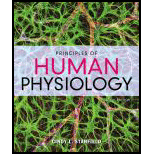
(a)
To explain:
The significance of the energy change in a reaction with regard to the direction of the reaction.
Introduction:
The reactions that progress in forward direction on their own are exergonic reactions, that is, they furnish out energy throughout the method. The reactions which are non spontaneous in nature, are referred to as endergonic reactions and these proceed only when the energy is provided.
(b)
To explain:
Whether the reaction releases energy or it requires.
Introduction:
The reactions that progress in forward direction on their own are exergonic reactions, that is, they furnish out energy throughout the method. The reactions, which are non spontaneous in nature, are referred to as endergonic reactions and these proceed only when the energy is provided.
Want to see the full answer?
Check out a sample textbook solution
Chapter 3 Solutions
Pearson eText Principles of Human Physiology -- Instant Access (Pearson+)
- Anwser these Discussion Questions: Part One Why were the plants kept in the dark prior to the experiment? Why is this important? Why is it important to boil the leaf? Explain why it was necessary to use boiling alcohol? What is the purpose of the iodine? Part Two What was the purpose of keeping the leaf in the dark and then covering it with a cardboard cut-out? What conclusions can you draw from this part of the lab? Part Three 7. In this experiment what was the purpose of adding the soda lime? 8. Why was a sealed bag placed around each plant? 9. What happened in the control plants? 10. What was the result on photosynthesis? Part Four 11. Why was a variegated leaf used in this experiment? !2. What conclusions can you draw about starch production in a variegated leaf?arrow_forwardHow did the color differences between the two bacterial species you used in this experiment help you determine if the streak plate method you performed was successful?arrow_forwardseries of two-point crosses were carried out among six loci (a, b, c, d, e and f), producing the following recombination frequencies. According to the data below, the genes can be placed into how many different linkage groups? Loci a and b Percent Recombination 50 a and c 14 a and d 10 a and e 50 a and f 50 b and c 50 b and d 50 b and e 35 b and f 20 c and d 5 c and e 50 c and f 50 d and e 50 d and f 50 18 e and f Selected Answer: n6 Draw genetic maps for the linkage groups for the data in question #5. Please use the format given below to indicate the genetic distances. Z e.g. Linkage group 1=P____5 mu__Q____12 mu R 38 mu 5 Linkage group 2-X_____3 mu__Y_4 mu sanightarrow_forward
- What settings would being able to isolate individual bacteria colonies from a mixed bacterial culture be useful?arrow_forwardCan I get a handwritten answer please. I'm having a hard time understanding this process. Thanksarrow_forwardSay you get AATTGGCAATTGGCAATTGGCAATTGGCAATTGGCAATTGGCAATTGGC 3ʹ and it is cleaved with Mspl restriction enzyme - how do I find how many fragments?arrow_forward
- Which marker does this DNA 5ʹ AATTGGCAATTGGCAATTGGCAATTGGCAATTGGCAATTGGCAATTGGC 3ʹ show?arrow_forwardThe Z value of LOD for two genes is 4, what does it mean for linkage and inheritance?arrow_forwardBiology How will you make a 50-ul reaction mixture with 2uM primer DNA using 10 uM primer DNA stocksolution and water?arrow_forward
 Human Anatomy & Physiology (11th Edition)BiologyISBN:9780134580999Author:Elaine N. Marieb, Katja N. HoehnPublisher:PEARSON
Human Anatomy & Physiology (11th Edition)BiologyISBN:9780134580999Author:Elaine N. Marieb, Katja N. HoehnPublisher:PEARSON Biology 2eBiologyISBN:9781947172517Author:Matthew Douglas, Jung Choi, Mary Ann ClarkPublisher:OpenStax
Biology 2eBiologyISBN:9781947172517Author:Matthew Douglas, Jung Choi, Mary Ann ClarkPublisher:OpenStax Anatomy & PhysiologyBiologyISBN:9781259398629Author:McKinley, Michael P., O'loughlin, Valerie Dean, Bidle, Theresa StouterPublisher:Mcgraw Hill Education,
Anatomy & PhysiologyBiologyISBN:9781259398629Author:McKinley, Michael P., O'loughlin, Valerie Dean, Bidle, Theresa StouterPublisher:Mcgraw Hill Education, Molecular Biology of the Cell (Sixth Edition)BiologyISBN:9780815344322Author:Bruce Alberts, Alexander D. Johnson, Julian Lewis, David Morgan, Martin Raff, Keith Roberts, Peter WalterPublisher:W. W. Norton & Company
Molecular Biology of the Cell (Sixth Edition)BiologyISBN:9780815344322Author:Bruce Alberts, Alexander D. Johnson, Julian Lewis, David Morgan, Martin Raff, Keith Roberts, Peter WalterPublisher:W. W. Norton & Company Laboratory Manual For Human Anatomy & PhysiologyBiologyISBN:9781260159363Author:Martin, Terry R., Prentice-craver, CynthiaPublisher:McGraw-Hill Publishing Co.
Laboratory Manual For Human Anatomy & PhysiologyBiologyISBN:9781260159363Author:Martin, Terry R., Prentice-craver, CynthiaPublisher:McGraw-Hill Publishing Co. Inquiry Into Life (16th Edition)BiologyISBN:9781260231700Author:Sylvia S. Mader, Michael WindelspechtPublisher:McGraw Hill Education
Inquiry Into Life (16th Edition)BiologyISBN:9781260231700Author:Sylvia S. Mader, Michael WindelspechtPublisher:McGraw Hill Education





